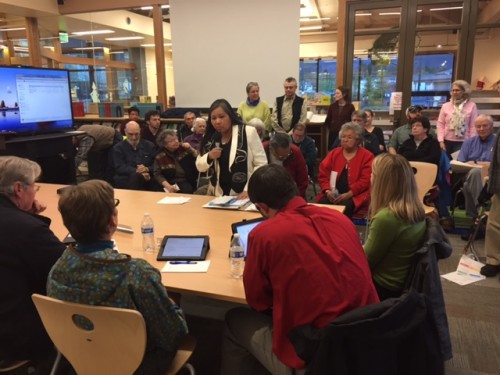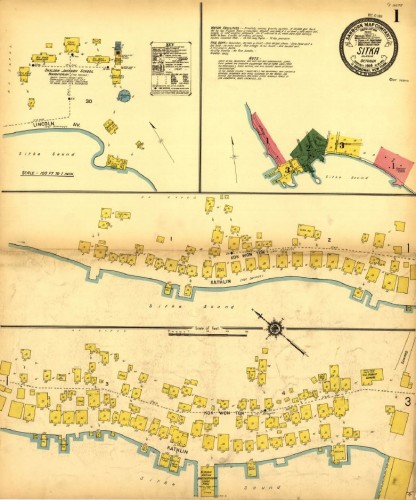
The Planning Commission is revising the land use section of Sitka’s Comprehensive Plan. And they’re inviting the public to weigh in. By devoting one meeting a month to land use, the commission hopes to get policies up to speed with modern practices. But at recent meeting, it was the past – not the future – that took center stage.
At the top of the meeting, the Planning and Community Development Commission presented a series of maps – drawn up by Russian and American settlers in the 1800s.
In tiny ink boxes, you can see the footprint of Sitka’s earliest homes and business. One set of maps, from the Sanborn Map and Publishing Company, were created for fire insurance purposes.


The presentation was intended to acquaint the 50 or so Sitkans in the audience with the early history of land use. But for some, it also touched a nerve.
Paulette Moreno is the president of the Alaska Native Sisterhood (ANS). Picking up the microphone shortly after the presentation, she said, “Out of respect for the Tlingit people and the land on which you are speaking on – Sheet’ka Kwaan – at every moment, at every time, you are a guest here.”
She then drew attention to one particular chapter of the plan, last updated in 2007. “We’re referred to as ‘Ethnic Diversity and Native Issues.’” Moreno paused. “Words are very important. I don’t consider myself or the people that walk amongst me or even any of our neighbors as ‘issues.’”
Moreno was not alone in challenging the commission to tread with sensitivity as they revise the comprehensive plan. Flanking her on both sides were tribal leaders and citizens. They took up the entire first row. They talked about how Alaskan Natives have been ostracized – both physically and politically – from the development process time and again.
Joy Wood is an officer with ANS. “A lot of the Natives just clam up as soon as soon as they see a white person with a piece of paper. I’m a notary public and there are some Natives that no matter how hard they try, I cannot get them to sign their names on paper. Because they are traumatized.
Scott Saline said some of that trauma is more recent. He criticized a past Planning Commission for the failing to install adequate drainage on Kaagwaantaan Street, thus damaging a clan house.
Saline lives on nearby Katlian Street, where the Tlingit set up a village segregated from the Russian side of town. “The property that I’ve owned in Indian Village – once I’ve studied how I’ve been able to buy that – I’m ashamed that I have that,” Saline told the commission. “I have learned how that paperwork and good faith has been taken advantage of. That is the culture of resistance, where what the grandfather struggles to forget the grandson fights to remember.
Culture. History. Trauma. These aren’t words you’d expect to hear at a land use meeting, but they illustrate how complex and fraught the conversation is around land use in Sitka.
During a break in the public testimony, I asked Maegan Bosak, planning and community development director, whether this surprised her.
KCAW: Did you ever see yourselves as accountable for addressing trauma and providing healing? Those are very different orders than creating a land use plan.
Bosak: Yes, very different from planning but I think in the end it’s a part of our community. And that’s what we’re charged with doing. We feel honored to be able to provide that service.
And in many ways, Bosak says, candid public testimony is exactly what the Planning Commission wants. “These meetings will not just be held at the library. We plan to have one at the senior center. We plan to have one at ANB (Alaska Native Brotherhood) hall. We plan to go around town to really highlight different groups and make sure that their voices are a part of this plan,” Bosak said.
In the zoning code of the 1970s, housing lots were 4,000 square feet. Now, they’re 8,000 square feet, which a handful of participants, like Michelle Putz, criticized as too big and too expensive. Putz said, “I really want to see us working toward smaller lots and more options to develop small housing on existing lots to make housing more affordable, so that all of us can live here.”
With conversation flowing, the meeting was also as staging ground for various groups and individuals to pitch development ideas. That included creating agricultural zones — particularly in land deemed unsafe for housing — building a new lost-cost trailer court or higher density properties, and adapting roads to be safer for walkers and bicyclists.
There’s a lot that’s possible in Sitka, but the challenges posed by precedent – by history – are there too. Nancy Yaw Davis complimented the commission trying to reconcile the two. “Part of what you’re working toward is a fuller awareness and validation of what really matters. Place names can help with that,” Yaw Davis said. “So as you move into neighborhoods, return to the history. Each of those lots. Each section of Sitka.”
The Planning and Zoning Commission hopes to finalize the revised comprehensive plan by the spring of 2017 and is dedicating the first Tuesday meeting of every month to that project.
